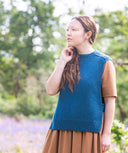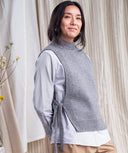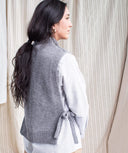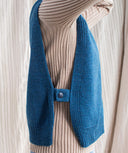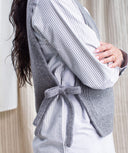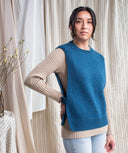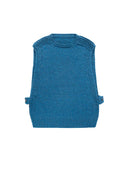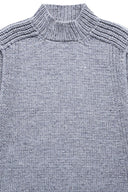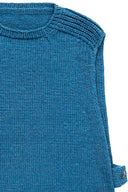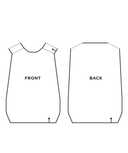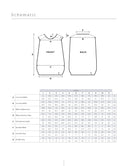Aegis
Side-Tie Tabard
Skill Level: 2 of 5
Regular price
$15.00
Languages Available: English
Pattern Specs
CONSTRUCTION
- The front is cast on and a ribbed hem with an i-cord edging is worked with tapered shaping to reach the full width of the body.
- Work continues straight in stockinette stitch with ribbed and i-cord edges for a few inches, then the front is shaped with decreases until the upper chest level.
- The shoulders are shaped with German Short Rows. At the same time, stitches are bound off for center front neck and the front neck is shaped with decreases by working the left and right front with separate balls of yarn.
- Remaining front shoulder stitches are placed on hold and the front is set aside.
- The back is worked as for the front through the unshaped portion of the body, then shaped more gradually with decreases up to the shoulder level.
- The back shoulders are shaped with German Short Rows, then stitches are bound off for the center back neck. Remaining stitches from the left back shoulder are placed on hold.
- Stitches for the saddle are cast on directly from the right back shoulder’s i-cord edge, using a modified I-Cord Cast On. The i-cord stitches are placed on hold, right front shoulder stitches (with the exception of i-cord edge stitches) are returned to the needle, and the saddle is worked perpendicularly in Shaker Rib to join the right front and back shoulders by consuming all stitches from each with decreases as it is worked, as for a knitted-on edging. Once back front all shoulder stitches have been consumed, saddle stitches are bound off.
- Held i-cord edge stitches of the saddle and right front are grafted together.
- The left front and back shoulders are joined in a similar manner, with the saddle stitches cast on from the left front shoulder’s i-cord edge.
- The neckband is picked up and worked circularly to a crew- or mock-neck length from the neck edge.
- The garment is tried on and placement for either side ties or button tabs is marked at each side of the front and back. Then, ties or button tabs are picked up and worked circularly using double knitting.
FINISHED DIMENSIONS
1 (2, 3, 4) (5, 6, 7) (8, 9, 10, 11)
- 12 (12¾, 13½, 14½) (14¾, 15½, 16½) (17½, 18½, 18¾, 20)” [30.5 (32.5, 34.5, 37) (37.5, 39.5, 42) (44.5, 47, 47.5 51) cm] cross-front panel width
- See Full Schematic for more sizing information
- Note: The garment does not have a true circumference; for best results we recommend choosing a size whose cross-front panel width is narrower than the wearer’s cross-front upper chest measurement (from underarm to underarm).
- Sample 1 is Size 2, with Mock Neck and Tie option, in Ash. Modeled by Melissa (dark-colored hair), 5’7”/170 cm tall, with 34”/86.5 cm chest.
- Sample 2 is Size 4, with Crew Neck and Button Tab option, in Diebenkorn. Modeled by Melissa (dark-colored hair), 5’7”/170 cm tall, with 34”/86.5 cm chest; also modeled by Leigh (lighter-colored hair), 5’6”/167.5 cm tall, with 36”/91.5 cm chest.
Need help picking a size? See our resource page on Selecting a Sweater Size 101.
GAUGE
- 20 stitches & 32 rows per 4”/10 cm in stockinette stitch, after blocking
Pattern Materials
YARN
Brooklyn Tweed Imbue Worsted — 104 yards (95 meters) per 50g skein
- 6^ (7, 8, 8) (9, 10, 10) (11, 11, 11^, 12) skeins
- Photographed in colors Ash and Diebenkorn
The marked skein counts "^" are near or exact to the listed yardage; consider adding an extra skein.
YARDAGE
- 615 (680, 735, 805) (900, 940, 985) (1050, 1120, 1135, 1200) yards [562 (622, 672, 736) (823, 860, 901) (960, 1024, 1038, 1097) meters] of worsted weight wool yarn
- Yardage is calculated with Crew Neck & Button Tab options. If Mock Neck option is worked, an additional 25-40 yards/23-37 meters of yarn will be needed for each size; if Tie option is worked, an additional 15-25 yards/14-23 meters of yarn will be needed.
NEEDLES
Main needle(s)
- Suggested Size: US 6 / 4 mm
- Straight or 24” (60 cm) circular needle(s)
Trim needle
- Suggested size US 5 / 3.75 mm
- One or two sizes smaller than main needle(s)
- One 16” (40 cm) circular needle
Techniques
Tutorials for all special techniques listed below are included in the pattern:
- Video — Rib Cabled Cast On
- Video — Short Rows: German Method
- Video — Fully Fashioned Double Decreases
- Video — I-Cord Cast On
- Video — Italian Tubular Bind Off
- Blocking 101
Errata
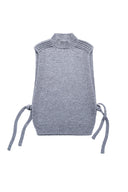
Aegis
Regular price
$15.00
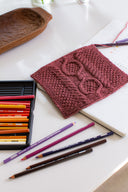
Uncompromising Excellence in Every Detail

